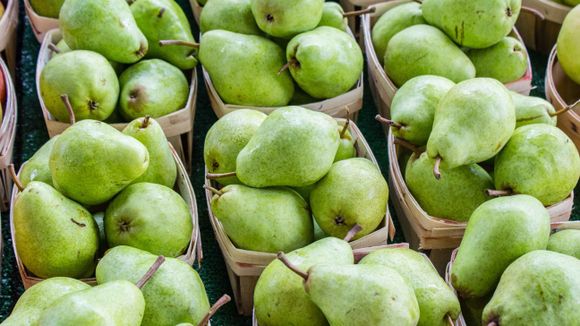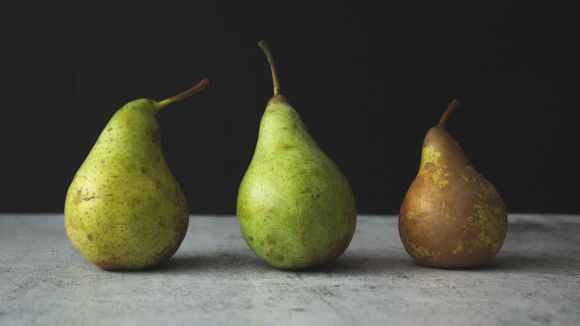The most important thing about pears
Pears are a member of the family of rose plants (Rosaceae), which besides roses contain a long list of fruits, including apples, apricots, cherries, aronia, peaches, plums, quinces, and others.
The common European pear (Pyrus Communis) [ref. 1] is a soft, sweet fruit with a fibrous center. These fruits are rich in essential antioxidants, plant compounds, and dietary fiber, making them extremely useful for everyone. There are other types of pears such as Olive Leaf (Pyrus Elaeagrifolia) [ref. 2] , Snow Pear (Pyrus Nivalis) [ref. 3] , Wild Himalayan pear (Pyrus Pashia) [ref. 4] , but in this article, we will focus on the first one.
Pears are especially rich in folate, vitamin C, copper, and potassium. They are also a good source of polyphenol antioxidants and other valuable substances from which their beneficial properties originate.
Health benefits provided by pears
Antioxidant and anti-inflammatory activity
Although pears are not an unusual source of conventional antioxidant or anti-inflammatory nutrients (e.g. vitamin E or omega-3 fatty acids), the phytonutrient category is where this fruit outperforms others.
For example, in the Baltimore Study of Aging [Ref. 5] (1,638 participants, average age range 62-69 years), the apple/pear combination was ranked as the second highest source of flavonols among all fruits and vegetables - partly because of the richness of epicatechin in pears. The average intake of flavonol in the study was about 14 milligrams per day, and one pear could provide about half that amount.
The list of phytonutrients found in pears is of particular interest to researchers, so let's see who they are:
- Hydroxybenzoic acids
- chlorogenic acid
- gentilic acid
- syringic acid
- vanillic acid
- Hydroxycinnamic acids
- coumaric acid
- ferulic acid
- 5-caffeoylquinic acid
- Flavanols
- catechin
- epicatechin
- Flavonols
- isorhamnetin
- Quercetin
- kaempferol
It has been proven that almost all these phytonutrients provide us with antioxidant as well as anti-inflammatory benefits. As a result, pear intake is already associated with a reduced risk of several common chronic diseases that begin with chronic inflammation and excessive oxidative stress. These diseases include heart disease and type 2 diabetes. [Ref. 6]
Pears may reduce the risk of type 2 diabetes and heart disease
As a very good source of dietary fiber, pears can be expected to protect us from developing type 2 diabetes, as well as heart disease. Adequate intake of dietary fiber is an established factor in reducing the risk of both diseases, and in the case of pears, this benefit can be even more pronounced due to the useful combination of soluble and insoluble fiber in this fruit. In addition to the fiber content, however, pears have other ways to help us protect ourselves from these diseases through flavonols, anthocyanins, and other compounds.
Pears likely to reduce cancer risk
The health benefits of fiber also extend to the area of cancer risk. Pear fiber can be associated not only with bile acids in general, but also with a special group of bile acids called secondary bile acids. Excessive amounts of secondary bile acids in the intestine can increase the risk of colorectal cancer (as well as other intestinal problems).
By binding together with secondary bile acids, pear fiber can help reduce their concentration in the intestines and reduce the risk of developing cancer. In the case of stomach cancer, it has also been shown that taking pears reduces the risk of cancer. Here, however, the main focus is not on fiber, but on phytonutrients, especially cinnamon acids (including cumacic acid, ferulinic acid and 5-caffeioylchinic acid). [Ref. 7]
How to choose and store pears

Since pears are very perishable after they are ripe,those you find in the store or at the market are usually unripe and will need a few days of maturation. Look for pears that are hard, but not too much. They should have smooth skin, no bruises or mold on them.
The color of pears of good quality may not be the same, as some may have brown spots on the skin. This is actually an acceptable characteristic and often reflects a more intense taste. Avoid pears that have deformities or have dark brown spots.
Tips for cooking with pears
Since the skin of pears provides about half of the total dietary fiber, as well as its antioxidant and anti-inflammatory phytonutrients, it is best not to white fruits, but to eat the whole pear.
Once cut, pears are quickly oxidized and acquire a brownish color. You can prevent this by dripping a few drops of lemon, lime, or orange juice onto the flesh.
A few easy ideas for quick serving and preparation of pears from us:
- Combine pears with green mustard, and watercress (Lepidium Sativum) [ref. 8] , leeks and walnuts for a delicious salad.
- Serve pears with goat or blue cheese for a delicious hors d'oeuvre.
- Add chopped pears, grated ginger, and honey to a millet porridge for a spicy-sweet snack.









